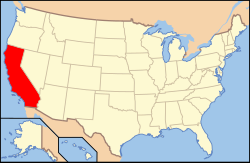This article has multiple issues. Please help improve it or discuss these issues on the talk page. (Learn how and when to remove these messages)
|
California State Park Peace Officers (S.P.P.O.) are fully sworn California State Police Officers, with two sub-classifications, the Ranger and the Lifeguard. S.P.P.O.s often use the title of State Police Officer during enforcement contact, as many Park Rangers and Lifeguards within municipalities, counties and special districts are armed Peace Officers, with authority throughout the state, on and off duty, like the California State Park Peace Officers law enforcement officer. State Park Peace Officers perform a wide variety of general law-enforcement activities, including complex criminal investigations, traffic enforcement, and participate in statewide task forces, for gang suspension, narcotics enforcement, auto theft, and fish and wildlife crimes, under the jurisdiction of the California State Parks. Duties include general law enforcement, aquatic rescue (by lifeguards and other certified officers), search and rescue, emergency medical response, interpretation of natural, historic and cultural resources, resource protection, park management and proactive enforcement patrol. The current sidearm of the California State Park Peace Officer is the Smith & Wesson M&P, the current patrol rifle is the Colt AR-15 Model LE6920, and the current patrol shotgun is the Remington Model 870 Police Magnum.
| California State Park Peace Officer | |
|---|---|
 | |
 | |
| Jurisdictional structure | |
| Operations jurisdiction | California, USA |
 | |
| Map of California State Park Peace Officer's jurisdiction | |
| General nature | |
| Operational structure | |
| Headquarters | Sacramento, California |
| Website | |
| California Park Ranger page | |
SPPOs are trained and designated as sworn California State Park Peace Officers. Their authority extends statewide (on or off duty). They patrol park grounds by vehicle, boat, and foot or horse patrol; enforce park regulations and issue citations; write reports; make physical arrests for misdemeanors, felonies, and warrants; conduct criminal and administrative investigations; take command in emergencies; perform search and rescue activities; assist in wildland and structural fire suppression; provide emergency medical assistance and aid; and may also perform traffic control and radio dispatching. Incumbents may perform specialized assignments in cliff rescue; ski patrol; scuba diving; ocean, surf, river, and lake rescue; horse patrol; patrol by aircraft; off-road vehicle and motorcycle patrol; or as a canine team handler.[1]
Functions
edit- Public safety
- Law-enforcement services
- Lifeguard services
- Medical aid/emergency medical response
- Operating and maintaining emergency equipment
- Visitor assistance
- Advising visitors of rules and regulations
- Providing general park information
- Public education and interpretation
- Community outreach
- Interpretive programs
- Junior Ranger and Lifeguard Programs
- Park Resource Protection and Management
Rank structure
edit- The California State Parks Peace Officers (SPPO) are broken up into two types of Law Enforcement officers; the SPPO - Ranger and the SPPO - Lifeguard.
Rangers
editLifeguards
editBoth Lifeguards and Rangers work in conjunction to enforce state law and park regulations in the 280 parks under the jurisdiction of the State of California.
Training
editAll State Parks Peace Officers must complete a Peace Officer Standards and Training (P.O.S.T.) academy before being sworn in as a Ranger or a Lifeguard. California State Parks hosts a P.O.S.T. academy specifically for S.P.P.O.s at the Butte College in Oroville, CA. [1] The Ranger academy requires 6 to 8 months to complete, depending on the class. Each class consists of up to 50 cadets, both lifeguard and ranger.
Ranger Cadet or Academy Applications
Difference in Training at the Academy
editLifeguards and rangers attend the same CA POST Peace Officer Academy. Lifeguards receive all the training as rangers. Lifeguards are also required to train in and complete the additional 8-day CA State Parks Lifeguard seasonal training either before or within one year after the completion of the POST Peace Officer Academy. During the POST Academy, lifeguards wear the blue uniform and rangers wear the tan and green.
Training After the Academy
editS.P.P.O.s continue training regularly upon graduation from the academy and are encouraged to further their knowledge and skill base to best serve the parks and people of California. Some training includes EMT training, K-9 Handler training, counter-terrorism training, and firearms training.
See also
editReferences
edit- ^ "State Park Peace Officer (Ranger) Series - CalHR". www.calhr.ca.gov. Retrieved 4 November 2024. This article incorporates text from this source, which is in the public domain.
- Lynch, Michael G. (2009). "Images of America Series". California State Park Rangers. Mount Pleasant, South Carolina: Arcadia Publishing. ISBN 9780738559933.